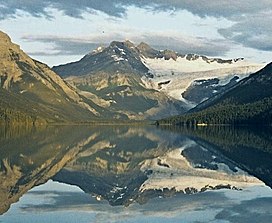Division Mountain
| Division Mountain | |
|---|---|
 Division Mountain reflected in Glacier Lake | |
| Highest point | |
| Elevation | 3,020 m (9,910 ft)[1] |
| Prominence | 340 m (1,120 ft)[2] |
| Parent peak | Christian Peak (3406 m)[2] |
| Listing | Mountains of Alberta Mountains of British Columbia |
| Coordinates | 51°53′21″N 117°00′31″W / 51.88917°N 117.00861°W[3] |
| Geography | |
| Country | Canada |
| Provinces | Alberta and British Columbia |
| Parent range | Canadian Rockies |
| Topo map | NTS 82N14 Rostrum Peak[3] |
| Climbing | |
| First ascent | 1918 by Interprovincial Boundary Commission[1] |
Division Mountain is located on the Continental Divide along the Alberta - British Columbia border of Canada. It also straddles the shared boundary of Banff National Park with Kootenay National Park in the Canadian Rockies. It was named in 1919 by Charles D. Walcott since the mountain divides the Lyell Icefield from the Mons Icefield.[1][2]
Geology
The mountain is composed of sedimentary rock laid down during the Precambrian to Jurassic periods.[4] Formed in shallow seas, this sedimentary rock was pushed east and over the top of younger rock during the Laramide orogeny.[5]
Climate
Based on the Köppen climate classification, the mountain experiences a subarctic climate with cold, snowy winters, and mild summers.[6] Temperatures can drop below -20 °C with wind chill factors below -30 °C in the winter.
See also
References
- ^ a b c "Division Mountain". cdnrockiesdatabases.ca. Retrieved 2019-08-11.
- ^ a b c "Division Mountain". Bivouac.com. Retrieved 2019-09-18.
- ^ a b "Division Mountain (Alberta)". Geographical Names Data Base. Natural Resources Canada. Retrieved 2019-09-18.
- ^ Belyea, Helen R. (1960). The Story of the Mountains in Banff National Park (PDF). parkscanadahistory.com (Report). Ottawa: Geological Survey of Canada. Archived (PDF) from the original on 2015-10-02. Retrieved 2019-09-13.
- ^ Gadd, Ben (2008). Geology of the Rocky Mountains and Columbias.
- ^ Peel, M. C.; Finlayson, B. L.; McMahon, T. A. (2007). "Updated world map of the Köppen−Geiger climate classification". Hydrol. Earth Syst. Sci. 11 (5): 1633–1644. Bibcode:2007HESS...11.1633P. doi:10.5194/hess-11-1633-2007. ISSN 1027-5606.



